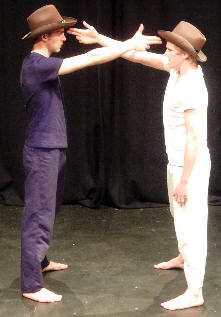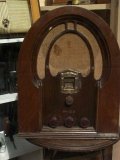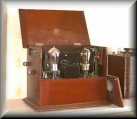HOW TO SET OUT THE PRODUCTION-POSTPRODUCTION DETAILS OF THE SCRIPT
| TECHNICAL NOTES NEEDED FOR EACH SCENE |
| Give clear information - (1) TECHNICAL (PRODUCTION - IN THE STUDIO - SOUND TECHNICIANS or 'SPOT'), (2) TECHNICAL (PRODUCTION - IN THE CONTROL ROOM or 'CUBICLE' - DIRECTOR, CONTROL PANEL OPERATOR, SOUND TECHNICIANS), (3) TECHNICAL (POSTPRODUCTION), (4) ACTORS & DIRECTING, (5) ACTORS (PLOT SUMMARY) LOOK AT THE EXAMPLES HERE |
 For full
description of PRODUCTION - POSTPRODUCTION, see Beck, Alan, Radio
Acting, London: A & C Black ISBN 0-7136-4631-4 Available
on Amazon. CLICK
HERE For full
description of PRODUCTION - POSTPRODUCTION, see Beck, Alan, Radio
Acting, London: A & C Black ISBN 0-7136-4631-4 Available
on Amazon. CLICK
HERE |
| Putting these extra notes into the SCRIPT ensures that TECHNICAL information is clear and shared. More detail should be added for the POSTPRODUCTION SCRIPT. |
| PRODUCTION - information such as SOUND CENTRE - FIXED SOUND CENTRE - the centre of the sound picture remains fixed in the same place + MOVING SOUND CENTRE - 'we go with' and (when necessary) microphone positions |
| PRODUCTION & POSTPRODUCTION - Atmos bed (underneath the scene dialogue) - establishes scene location or scenery |
 Scene boundaries - CHART FOR
CHOICES - straight cut / fade in / fade out / crossfade / 'Archers'
fade / music bridge / FX bridge / montage Scene boundaries - CHART FOR
CHOICES - straight cut / fade in / fade out / crossfade / 'Archers'
fade / music bridge / FX bridge / montage |
| Music - underscoring, signature tune (for soap or play), emotional, dramatic, music bridge |
|
EXAMPLE - CHARACTERS: PENELOPE, CHARITY EXAMPLE - 'THE CANTERBURY VAMPIRES' 6.1 SUMMARY OF SCENE: CHARITY meets PENELOPE and is challenged to reveal her magic. She is embarrassed. Listeners are reintroduced to CHARITY (INEXPERIENCED GIRL) and PENELOPE (FEISTY GIRL). |
| Most PRODUCTION in the STUDIO and OB is done OUT OF SEQUENCE (not done in order of the SCRIPT). All involved must have definitive SCRIPT details. |
| STUDIO - working at speed, PRODUCTION TEAM and ACTORS have to get acquainted with each new scene. Hence the importance of listing CHARACTERS in the SCRIPT and a SHORT SUMMARY of what goes on in the scene, and technical details. This saves the DIRECTOR time. |
|
|
| POSTPRODUCTION - ensure STANDARDIZING FILE NAMES for all TEAM. |
| SCRIPT TECHNICAL NOTES are essential for the move from PRODUCTION into POSTPRODUCTION - see LOAD MATERIAL FROM PRODUCTION |
| You number each scene (as 3.1, 3.2 etc.) - important for coordinating the whole script and for production, when the scenes will probably NOT be recorded in the sequence that the listeners will eventually hear. |
| ABOVE ALL, YOU ARE PART OF A TEAM AND YOU COMMUNICATE TOGETHER RAPIDLY AND EFFICIENTLY. |
STARTING-UP - GETTING THE 'IDEA' - TEAM-WORK - SCRIPTING
HOW MANY WORDS FOR A 5-MINUTE EPISODE? HOW MANY SCENES?
| ALAN BECK'S FORMULA FOR THE MAIN CHARACTERS |
| Types of radio plays (fiction and mixed genres) |
| Storyboard - layout of scenes and details - how to make it work for you |
|
|
 ACTORS - CHARACTERS
in the scene & a SHORT SUMMARY of what goes on in the scene
ACTORS - CHARACTERS
in the scene & a SHORT SUMMARY of what goes on in the scene


